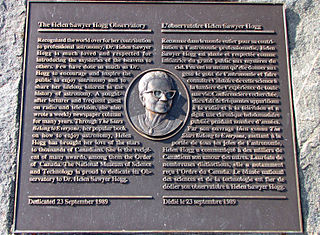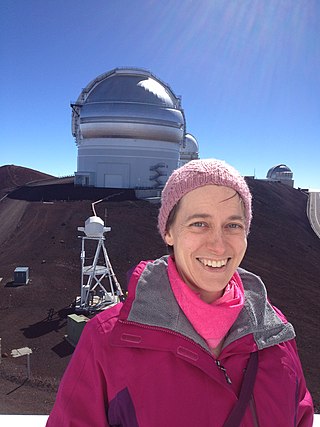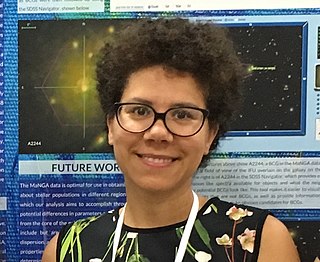Related Research Articles

Helen Battles Sawyer Hogg was an American-Canadian astronomer who pioneered research into globular clusters and variable stars. She was the first female president of several astronomical organizations and a notable woman of science in a time when many universities would not award scientific degrees to women. Her scientific advocacy and journalism included astronomy columns in the Toronto Star and the Journal of the Royal Astronomical Society of Canada. She was considered a "great scientist and a gracious person" over a career of sixty years.

Vera Florence Cooper Rubin was an American astronomer who pioneered work on galaxy rotation rates. She uncovered the discrepancy between the predicted and observed angular motion of galaxies by studying galactic rotation curves. Identifying the galaxy rotation problem, her work provided the first evidence for the existence of dark matter. These results were confirmed over subsequent decades.

Eleanor Margaret Burbidge, FRS (née Peachey; 12 August 1919 – 5 April 2020) was a British-American observational astronomer and astrophysicist. In the 1950s, she was one of the founders of stellar nucleosynthesis and was first author of the influential B2FH paper. During the 1960s and 1970s she worked on galaxy rotation curves and quasars, discovering the most distant astronomical object then known. In the 1980s and 90s she helped develop and utilise the Faint Object Spectrograph on the Hubble Space Telescope. Burbidge was well known for her work opposing discrimination against women in astronomy.
Amy J. Barger is an American astronomer and Henrietta Leavitt Professor of Astronomy at the University of Wisconsin–Madison. She is considered a pioneer in combining data from multiple telescopes to monitor multiple wavelengths and in discovering distant galaxies and supermassive black holes, which are outside of the visible spectrum. Barger is an active member of the International Astronomical Union.
Lisa Jennifer Kewley is an Australian Astrophysicist and current Director of the Center for Astrophysics | Harvard & Smithsonian. Previously, Kewley was Director of the ARC Centre of Excellence for All Sky Astrophysics in 3-D and ARC Laureate Fellow at the Australian National University College of Physical and Mathematical Sciences, where she was also a Professor. Specialising in galaxy evolution, she won the Annie Jump Cannon Award in Astronomy in 2005 for her studies of oxygen in galaxies, and the Newton Lacy Pierce Prize in Astronomy in 2008. In 2014 she was elected a fellow of the Australian Academy of Science. In 2020 she received the James Craig Watson Medal. In 2021 she was elected as an international member of the National Academy of Sciences. In 2022 she became the first female director of the Center for Astrophysics | Harvard & Smithsonian.

Kenneth Charles Freeman is an Australian astronomer and astrophysicist who is currently Duffield Professor of Astronomy in the Research School of Astronomy and Astrophysics at the Mount Stromlo Observatory of the Australian National University in Canberra. He was born in Perth, Western Australia in 1940, studied mathematics and physics at the University of Western Australia, and graduated with first class honours in applied mathematics in 1962. He then went to Cambridge University for postgraduate work in theoretical astrophysics with Leon Mestel and Donald Lynden-Bell, and completed his doctorate in 1965. Following a postdoctoral appointment at the University of Texas with Gérard de Vaucouleurs, and a research fellowship at Trinity College, Cambridge, he returned to Australia in 1967 as a Queen Elizabeth Fellow at Mount Stromlo. Apart from a year in the Kapteyn Institute in Groningen in 1976 and some occasional absences overseas, he has been at Mount Stromlo ever since.
Carolin Susan Crawford is a British communicator of science and astrophysicist. She is an emeritus member of the Institute of Astronomy, Cambridge and an emeritus fellow of Emmanuel College, Cambridge.

Warrick John Couch is an Australian professional astronomer. He is currently a professor at Swinburne University of Technology in Melbourne. He was previously the Director of Australia's largest optical observatory, the Australian Astronomical Observatory (AAO). He was also the President of the Australian Institute of Physics (2015–2017), and a non-executive director on the Board of the Giant Magellan Telescope Organization. He was a founding non-executive director of Astronomy Australia Limited.

Amanda Elaine Bauer is an American professional astronomer and science communicator. She is the Deputy Director and Head of Science and Education at Yerkes Observatory in Williams Bay, Wisconsin. She was previously based in Tucson, Arizona, working as Head of Education and Public Outreach at the Large Synoptic Survey Telescope. From 2013 to 2016 she was a Research Astronomer at the Australian Astronomical Observatory (AAO). Her principal field of research concerns how galaxies form, how they create new stars, and particularly why they suddenly stop creating new stars.

Debra Meloy Elmegreen is an American astronomer. She was the first woman to graduate from Princeton University with a degree in astrophysics, and she was the first female post-doctoral researcher at the Carnegie Observatories.
Judith Gamora Cohen, is an American astronomer and the Kate Van Nuys Page Professor of Astronomy at the California Institute of Technology. She is a recognized expert regarding the Milky Way Galaxy, particularly with respect to the Galaxy's outer halo. She also played a key role in the design and construction of the Keck Telescope.
Emily Levesque is an American astronomer and assistant professor in the Department of Astronomy at the University of Washington. She is renowned for her work on massive stars and using these stars to investigate galaxy formation. In 2014, she received the Annie Jump Cannon Award for her innovative work on gamma ray bursts and the Sloan Fellowship in 2017. In 2015, Levesque, Rachel Bezanson, and Grant R. Tremblay published an influential paper, which critiqued the use of the Physics GRE as an admissions cutoff criterion for astronomy postgraduate programs by showing there was no statistical correlation between applicant's score and later success in their academic careers. Subsequently, the American Astronomical Society adopted the stance that the Physics GRE should not be mandatory for graduate school applications, and many graduate astronomy programs have since removed the Physics GRE as a required part of their graduate school applications. She is also the author of the 2020 popular science book The Last Stargazers: The Enduring Story of Astronomy's Vanishing Explorers.
Barbara A. Williams is an American radio astronomer and the first African-American woman to earn a PhD in astronomy. Her research largely focused on compact galaxy groups, in particular observations of their emissions in the H I region in order to build up a larger scale picture of the structure and evolution of galaxies. Williams was named as the Outstanding Young Woman of America in 1986 and is currently a retired Associate Professor in the Department of Physics and Astronomy at the University of Delaware.

Pauline Barmby is a Canadian astronomer currently based at the University of Western Ontario. She studies galaxies, their formation and evolution from an observational standpoint. She studies both nearby galaxies and those at high redshift using telescopes like the Spitzer Space Telescope. She is the co-chair, with Bryan Gaensler, of the Canadian Astronomy 2020 Long Range Plan.
Deidre A. Hunter is an American astronomer at Lowell Observatory. Her primary research area is tiny irregular galaxies — their origins, evolution and star production, and the shapes that are formed. She uses many parts of the electromagnetic spectrum, and includes spectroscopy in her approach.

Louise Olivia Violet Edwards is a Canadian astronomer and assistant professor of physics at California Polytechnic State University, and is one of the first Black Canadians to receive a PhD in astronomy. In 2002, she was pictured on a Canadian stamp.
Alyson Brooks is an American theoretical astrophysicist and professor at Rutgers University. She uses large-scale simulations to determine how galaxies form.
Kathleen DeGioia Eastwood is an American astronomer known for her research on the formation and evolution of massive stars, and for her work on undergraduate education in astronomy. She is a professor emerita of astronomy and planetary science at Northern Arizona University.
Eileen Dolores Friel is an American astronomer specializing in the metallicity of star clusters. She is a former director of the Maria Mitchell Observatory and Lowell Observatory, and a professor emeritus of astronomy at Indiana University.
Maritza Arlene Lara-López is a Mexican astronomer whose research interests include metallicity in galaxy formation and evolution and extragalactic astronomy. She is a participant in the Galaxy And Mass Assembly survey, and a researcher and Ramón y Cajal Fellow in the faculty of physical sciences at the Complutense University of Madrid.
References
- ↑ Birth year from WorldCat Identities, retrieved 2022-05-26
- ↑ Rennie, John (2012), "Reading the clues in galaxy clusters", Research Magazine, Boston University, retrieved 2022-05-26
- ↑ Becker, Kate (July 26, 2017), "Galaxy Clusters Offer Clues to Dark Matter and Dark Energy: Astronomer's 20-year quest delivers trove of far-flung clusters", The Brink, Boston University, retrieved 2022-05-26
- ↑ Astronomy faculty, Boston University, retrieved 2022-05-26
- 1 2 Curriculum vitae (PDF), March 2019, retrieved 2022-05-26
- ↑ AAS Fellows, American Astronomical Society, retrieved 2022-05-26